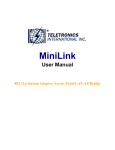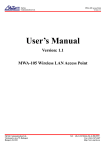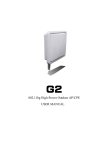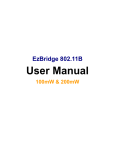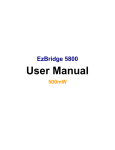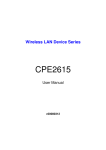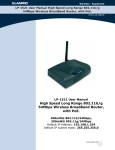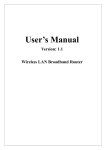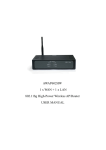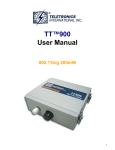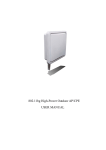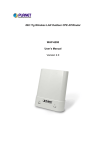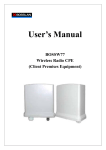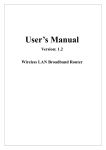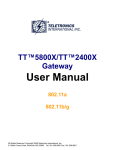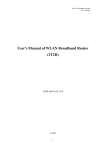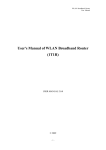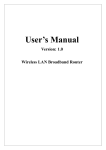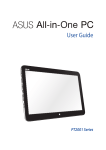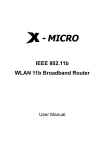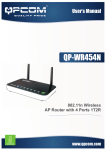Download EZStation2 User Manual
Transcript
EZStation2 User Manual Rev. A 2.4GHz 400mW 802.11b/g Radio with 15dBi Patch Antenna Disclaimers No part of this documentation may be reproduced in any form or by any means or used to make any derivative work (such as translation, transformation or adaptation) without written permission from the copyright owner. All other trademarks and registered trademarks are the property of their respective owners. Statement of Conditions We may make improvements or changes in the product described in this documentation at any time. The information regarding the product in this manual is subject to change without notice. We assume no responsibility for errors contained herein or for direct, indirect, special, incidental or consequential damages with the furnishing, performance or use of this manual or equipment supplied with it, even if the suppliers have been advised about the possibility of such damages. Electronic Emission Notices This device complies with Part 15 of the FCC Rules. Operation is subject to the following two conditions: (1)This device may not cause harmful interference. (2)This device must accept any interference received, including interference that may cause undesired operation. FCC INFORMATION The Federal Communication Commission Radio Frequency Interference Statement includes the following paragraph: The equipment has been tested and found to comply with the limits for a Class B Digital Device, pursuant to part 15 of the FCC Rules. These limits are designed to provide reasonable protection against harmful interference in a residential installation. This equipment usage generates radio frequency energy and, if not installed and used in accordance with the instructions, may cause harmful interference to radio communication. However, there is no grantee that interference will not occur in a particular installation. If this equipment does cause harmful interference to radio or television reception, which can be determined by turning the equipment off and on, the user is encouraged to try to correct the interference by one or more of the following measures: • Reorient or relocate the receiving antenna. • Increase the separation between the equipment and receiver. • Connect the equipment into an outlet on a circuit different from that to which the receiver is connected. • Consult the dealer or an experienced radio/TV technician for help. The equipment is for home or office use. IMPORTANT NOTE FCC RF Radiation Exposure Statement: This equipment complies with FCC RF radiation exposure limits set forth for an uncontrolled environment. This equipment should be installed and operated with a minimum distance of 20cm between the antenna and your body and must not be co-located or operating in conjunction with any other antenna or transmitter. Caution: Changes or modifications not expressly approved by the party responsible for compliance could void the user's authority to operate the equipment. Before Start to Configure The WLAN Broadband Router is delivered with the following factory default parameters on the Ethernet LAN interfaces. Default IP Address: 192.168.1.254 Default IP subnet mask: 255.255.255.0 WEB login User Name: <empty> WEB login Password: <empty> The device has three operation modes (Gateway/Bridge/WISP). The default IP addresses for the device are 192.168.1.254, so you need to make sure the IP address of your PC is in the same subnet as the device, such as 192.168.1.X. It will take about 55 seconds to complete the boot up sequence after power on. Prepare your PC to configure the WLAN Broadband Router For OS of Microsoft Windows 95/ 98/ Me: 1. Click the Start button and select Settings, then click Control Panel. The Control Panel window will appear. Note: Windows Me users may not see the Network control panel. If so, select View all Control Panel options on the left side of the window 2. Move mouse and double-click the right button on Network icon. The Network window will appear. 3. Check the installed list of Network Components. If TCP/IP is not installed, click the Add button to install it; otherwise go to step 6. 4. Select Protocol in the Network Component Type dialog box and click Add button. 5. Select TCP/IP in Microsoft of Select Network Protocol dialog box then click OK button to install the TCP/IP protocol, it may need the Microsoft Windows CD to complete the installation. Close and go back to Network dialog box after the TCP/IP installation. 6. Select TCP/IP and click the properties button on the Network dialog box. 7. Select Specify an IP address and type in values as following example. IP Address: 192.168.1.1, any IP address within 192.168.1.1 to 192.168.1.253 is good to connect the Wireless LAN Access Point. IP Subnet Mask: 255.255.255.0 8. Click OK and reboot your PC after completes the IP parameters setting. For OS of Microsoft Windows 2000, XP: 1. Click the Start button and select Settings, then click Control Panel. The Control Panel window will appear. 2. Move mouse and double-click the right button on Network and Dial-up Connections icon. Move mouse and double-click the Local Area Connection icon. The Local Area Connection window will appear. Click Properties button in the Local Area Connection window. 3. Check the installed list of Network Components. If TCP/IP is not installed, click the Add button to install it; otherwise go to step 6. 4. Select Protocol in the Network Component Type dialog box and click Add button. 5. Select TCP/IP in Microsoft of Select Network Protocol dialog box then click OK button to install the TCP/IP protocol, it may need the Microsoft Windows CD to complete the installation. Close and go back to Network dialog box after the TCP/IP installation. 6. Select TCP/IP and click the properties button on the Network dialog box. 7. Select Specify an IP address and type in values as following example. IP Address: 192.168.1.1, any IP address within 192.168.1.1 to 192.168.1.253 is good to connect the Wireless LAN Access Point. IP Subnet Mask: 255.255.255.0 8. Click OK to completes the IP parameters setting. For OS of Microsoft Windows NT: 1. Click the Start button and select Settings, then click Control Panel. The Control Panel window will appear. 2. Move mouse and double-click the right button on Network icon. The Network window will appear. Click Protocol tab from the Network window. 3. Check the installed list of Network Protocol window. If TCP/IP is not installed, click the Add button to install it; otherwise go to step 6. 4. Select Protocol in the Network Component Type dialog box and click Add button. 5. Select TCP/IP in Microsoft of Select Network Protocol dialog box then click OK button to install the TCP/IP protocol, it may need the Microsoft Windows CD to complete the installation. Close and go back to Network dialog box after the TCP/IP installation. 6. Select TCP/IP and click the properties button on the Network dialog box. 7. Select Specify an IP address and type in values as following example. IP Address: 192.168.1.1, any IP address within 192.168.1.1 to 192.168.1.253 is good to connect the Wireless LAN Access Point. IP Subnet Mask: 255.255.255.0 8. Click OK to complete the IP parameters setting. This page shows the current status and some basic settings of the device, includes system, wireless, Ethernet LAN and WAN configuration information. Item System Uptime Description It shows the duration since WLAN Broadband Firmware version Router is powered on. It shows the firmware version of WLAN Broadband Router. Wireless configuration Mode It shows wireless operation mode Band It shows the current wireless operating frequency. SSID It shows the SSID of this WLAN Broadband Router. The SSID is the unique name of WLAN Broadband Router and shared among its service area, so all devices attempts to join the same wireless network can identify it. Channel Number It shows the wireless channel connected currently. Encryption It shows the status of encryption function. BSSID It shows the BSSID address of the WLAN Broadband Router. BSSID is a six-byte address. Associated Clients It shows the number of connected clients (or stations, PCs). TCP/IP configuration Attain IP Protocol It shows type of connection. IP Address It shows the IP address of LAN interfaces of WLAN Broadband Router. Subnet Mask It shows the IP subnet mask of LAN interfaces of WLAN Broadband Router. Default Gateway It shows the default gateway setting for LAN interfaces outgoing data packets. DHCP Server It shows the DHCP server is enabled or not. MAC Address It shows the MAC address of LAN interfaces of WLAN Broadband Router. WAN configuration Attain IP Protocol It shows how the WLAN Broadband Router gets the IP address. The IP address can be set manually to a fixed one or set dynamically by DHCP server or attain IP by PPPoE / PPTP connection. IP Address It shows the IP address of WAN interface of WLAN Broadband Router. Subnet Mask It shows the IP subnet mask of WAN interface of WLAN Broadband Router. Default Gateway It shows the default gateway setting for WAN interface outgoing data packets. DNS1/DNS2/DNS3 It shows the DNS server information. MAC Address It shows the MAC address of WAN interface of WLAN Broadband Router. Setup Wizard This page guides you to configure wireless broadband router for first time Operation Mode This page followed by Setup Wizard page to define the operation mode. Time Zone Setting This page is used to enable and configure NTP client LAN Interface Setup This page is used to configure local area network IP address and subnet mask WAN Interface Setup This page is used to configure WAN access type Wireless Basic Settings This page is used to configure basic wireless parameters like Band, Mode, Network Type SSID, Channel Number, Enable Mac Clone(Single Ethernet Client) Wireless Security Setup This page is used to configure wireless security Operation Mode This page is used to configure which mode wireless broadband router acts Item Gateway Bridge Wireless ISP Apply Changes Reset Description Traditional gateway configuration. It always connects internet via ADSL/Cable Modem. LAN interface, WAN interface, Wireless interface, NAT and Firewall modules are applied to this mode Each interface (LAN, WAN and Wireless) regards as bridge. NAT, Firewall and all router’s functions are not supported Switch Wireless interface to WAN port and all Ethernet ports in bridge mode. Wireless interface can do all router’s functions Click the Apply Changes button to complete the new configuration setting. Click the Reset button to abort change and recover the previous configuration setting. Wireless - Basic Settings This page is used to configure the parameters for wireless LAN clients that may connect to your Broadband Router. Here you may change wireless encryption settings as well as wireless network parameters. Item Disable Wireless LAN Interface Band Mode Site Survey SSID Channel Number Associated Clients Enable Mac Clone (Single Ethernet Client) Enable Universal Repeater Mode SSID of Extended Interface Apply Changes Reset Description Click on to disable the wireless LAN data transmission. Click to select 2.4GHz(B) / 2.4GHz(G) / 2.4GHz(B+G) Click to select the WLAN AP / Client / WDS / AP+WDS wireless mode. The Site Survey button provides tool to scan the wireless network. If any Access Point or IBSS is found, you could choose to connect it manually when client mode is enabled. Refer to 3.3.9 Site Survey. It is the wireless network name. The SSID can be 32 bytes long. Select the wireless communication channel from pull-down menu. Click the Show Active Clients button to open Active Wireless Client Table that shows the MAC address, transmit-packet, receive-packet and transmission-rate for each associated wireless client. Take Laptop NIC MAC address as wireless client MAC address. [Client Mode only] Click to enable Universal Repeater Mode Assign SSID when enables Universal Repeater Mode. Click the Apply Changes button to complete the new configuration setting. Click the Reset button to abort change and recover the previous configuration setting. Wireless - Advanced Settings These settings are only for more technically advanced users who have a sufficient knowledge about wireless LAN. These settings should not be changed unless you know what effect the changes will have on your WLAN Broadband Router. Item Authentication Type Fragment Threshold RTS Threshold Beacon Interval Data Rate Preamble Type Broadcast SSID IAPP Description Click to select the authentication type in Open System, Shared Key or Auto selection. Set the data packet fragmentation threshold, value can be written between 256 and 2346 bytes. Set the RTS Threshold, value can be written between 0 and 2347 bytes. Set the Beacon Interval, value can be written between 20 and 1024 ms. Select the transmission data rate from pull-down menu. Data rate can be auto-select, 11M, 5.5M, 2M or 1Mbps. Click to select the Long Preamble or Short Preamble support on the wireless data packet transmission. Click to enable or disable the SSID broadcast function. Click to enable or disable the IAPP function. 802.11g Protection RF Output Power Turbo Mode Protect 802.11b user. To adjust transmission power level. Click to Enable/Disable turbo mode.(Only apply to WLAN IC of Realtek). Block Relay Between Click Enabled/Disabled to decide if blocking Clients relay packets between clients. WMM Click Enabled/Disabled to init WMM feature. ACK Timeout Set ACK timeout value. It shows current time in the end. Apply Changes Click the Apply Changes button to complete the new configuration setting. Reset Click the Reset button to abort change and recover the previous configuration setting. Wireless - Security Setup This page allows you setup the wireless security. Turn on WEP, WPA, WPA2 by using encryption keys could prevent any unauthorized access to your wireless network. Item Encryption Use 802.1x Authentication WPA Authentication Mode Pre-Shared Key Format Pre-Shared Key Enable Pre-Authentication Authentication RADIUS Server Apply Changes Reset WEP Key Setup Description Select the encryption supported over wireless access. The encryption method can be None, WEP, WPA(TKIP), WPA2 or WPA2 Mixed While Encryption is selected to be WEP. Click the check box to enable IEEE 802.1x authentication function. While Encryption is selected to be WPA. Click to select the WPA Authentication Mode with Enterprise (RADIUS) or Personal (Pre-Shared Key). While Encryption is selected to be WPA. Select the Pre-shared key format from the pull-down menu. The format can be Passphrase or Hex (64 characters). [WPA, Personal(Pre-Shared Key) only] Fill in the key value. [WPA, Personal(Pre-Shared Key) only] Click to enable Pre-Authentication. [WPA2/WPA2 Mixed only, Enterprise only] Set the IP address, port and login password information of authentication RADIUS sever. Click the Apply Changes button to complete the new configuration setting. Click the Reset button to abort change and recover the previous configuration setting. Item Key Length Key Format Default Tx Key Encryption Key 1 Encryption Key 2 Encryption Key 3 Encryption Key 4 Apply Changes Close Reset Description Select the WEP shared secret key length from pull-down menu. The length can be chose between 64-bit and 128-bit (known as “WEP2”) keys. The WEP key is composed of initialization vector (24 bits) and secret key (40-bit or 104-bit). Select the WEP shared secret key format from pull-down menu. The format can be chose between plant text (ASCII) and hexadecimal (HEX) code. Set the default secret key for WEP security function. Value can be chose between 1 and 4. Secret key 1 of WEP security encryption function. Secret key 2 of WEP security encryption function. Secret key 3 of WEP security encryption function. Secret key 4 of WEP security encryption function. Click the Apply Changes button to complete the new configuration setting. Click to close this WEP Key setup window. Click the Reset button to abort change and recover the previous configuration setting. WEP encryption key (secret key) length: Length 64-bit Format ASCII HEX 5 characters 10 hexadecimal codes 128-bit 13 characters 26 hexadecimal codes Wireless - Access Control If you enable wireless access control, only those clients whose wireless MAC addresses are in the access control list will be able to connect to your Access Point. When this option is enabled, no wireless clients will be able to connect if the list contains no entries. Item Wireless Access Control Mode MAC Address Comment Apply Changes Reset Current Access Control List Delete Selected Delete All Reset Description Click the Disabled, Allow Listed or Deny Listed of drop down menu choose wireless access control mode. This is a security control function; only those clients registered in the access control list can link to this WLAN Broadband Router. Fill in the MAC address of client to register this WLAN Broadband Router access capability. Fill in the comment tag for the registered client. Click the Apply Changes button to register the client to new configuration setting. Click the Reset button to abort change and recover the previous configuration setting. It shows the registered clients that are allowed to link to this WLAN Broadband Router. Click to delete the selected clients that will be access right removed from this WLAN Broadband Router. Click to delete all the registered clients from the access allowed list. Click the Reset button to abort change and recover the previous configuration setting. WDS Settings Wireless Distribution System uses wireless media to communicate with other APs, like the Ethernet does. To do this, you must set these APs in the same channel and set MAC address of other AP that you want to communicate with in the table and then enable the WDS. Item Enable WDS MAC Address Comment Apply Changes Reset Set Security Show Statistics Delete Selected Delete All Reset Description Click the check box to enable wireless distribution system. Fill in the MAC address of AP to register the wireless distribution system access capability. Fill in the comment tag for the registered AP. Click the Apply Changes button to register the AP to new configuration setting. Click the Reset button to abort change and recover the previous configuration setting. Click button to configure wireless security like WEP(64bits), WEP(128bits), WPA(TKIP), WPA2(AES) or None It shows the TX, RX packets, rate statistics Click to delete the selected clients that will be removed from the wireless distribution system. Click to delete all the registered APs from the wireless distribution system allowed list. Click the Reset button to abort change and recover the previous configuration setting. WDS Security Setup Requirement: Set [Wireless]->[Basic Settings]->[Mode]->AP+WDS This page is used to configure the wireless security between APs. WDS AP Table This page is used to show WDS statistics Item MAC Address Tx Packets Tx Errors Rx Packets Tx Rare (Mbps) Refresh Close Description It shows the MAC Address within WDS. It shows the statistic count of sent packets on the wireless LAN interface. It shows the statistic count of error sent packets on the Wireless LAN interface. It shows the statistic count of received packets on the wireless LAN interface. It shows the wireless link rate within WDS. Click to refresh the statistic counters on the screen. Click to close the current window. Site Survey This page is used to view or configure other APs near yours. Item SSID BSSID Channel Type Encrypt Signal Select Description It shows the SSID of AP. It shows BSSID of AP. It show the current channel of AP occupied. It show which type AP acts. It shows the encryption status. It shows the power level of current AP. Click to select AP or client you’d like to connect. Refresh Connect Click the Refresh button to re-scan site survey on the screen. Click the Connect button to establish connection. LAN Interface Setup This page is used to configure the parameters for local area network that connects to the LAN ports of your WLAN Broadband Router. Here you may change the setting for IP address, subnet mask, DHCP, etc. Item IP Address Description Fill in the IP address of LAN interfaces of this WLAN Access Point. Subnet Mask Fill in the subnet mask of LAN interfaces of this WLAN Access Point. Default Gateway Fill in the default gateway for LAN interfaces out going data packets. DHCP Click to select Disabled, Client or Server in different operation mode of wireless Access Point. DHCP Client Range Fill in the start IP address and end IP address to allocate a range of IP addresses; client with DHCP function set will be assigned an IP address from the range. Show Client Click to open the Active DHCP Client Table window that shows the active clients with their assigned IP address, MAC address and time expired information. [Server mode only] DNS Server Manual setup DNS server IP address. Domain Name Assign Domain Name and dispatch to DHCP clients. It is optional field. 802.1d Spanning Select to enable or disable the IEEE 802.1d Tree Spanning Tree function from pull-down menu. Clone MAC Address Fill in the MAC address that is the MAC address to be cloned. Apply Changes Click the Apply Changes button to complete the new configuration setting. Reset Click the Reset button to abort change and recover the previous configuration setting. WAN Interface Setup This page is used to configure the parameters for wide area network that connects to the WAN port of your WLAN Broadband Router. Here you may change the access method to Static IP, DHCP, PPPoE or PPTP by click the item value of WAN Access Type. Static IP Item Static IP Description Click to select Static IP support on WAN interface. There are IP address, subnet mask and default gateway settings need to be done. IP Address If you select the Static IP support on WAN interface, fill in the IP address for it. Subnet Mask If you select the Static IP support on WAN interface, fill in the subnet mask for it. Default Gateway If you select the Static IP support on WAN interface, fill in the default gateway for WAN interface out going data packets. MTU Size Fill in the mtu size of MTU Size. The default value is 1400 DNS 1 Fill in the IP address of Domain Name Server 1. DNS 2 Fill in the IP address of Domain Name Server 2. DNS 3 Fill in the IP address of Domain Name Server 3. Clone MAC Address Fill in the MAC address that is the MAC address to be cloned. Enable uPNP Click the checkbox to enable uPNP function. Enable Web Server Click the checkbox to enable web configuration Access on WAN from WAN side. Enable WAN Echo Click the checkbox to enable WAN ICMP Reply response. Enable IPsec pass Click the checkbox to enable IPSec packet pass through on VPN through connection Enable PPTP pass Click the checkbox to enable PPTP packet pass through on VPN through connection Enable L2TP pass Click the checkbox to enable L2TP packet pass through on VPN through connection Set TTL value Click to Enable and set Time to Live value. Apply Changes Click the Apply Changes button to complete the new configuration setting. Reset Click the Reset button to abort change and recover the previous configuration setting. DHCP Client Item DHCP Client Description Click to select DHCP support on WAN interface for IP address assigned automatically from a DHCP server. Host Name Fill in the host name of Host Name. The default value is empty MTU Size Fill in the mtu size of MTU Size. The default value is 1400 Attain DNS Click to select getting DNS address for DHCP Automatically support. Please select Set DNS Manually if the DHCP support is selected. Set DNS Manually Click to select getting DNS address for DHCP support. DNS 1 Fill in the IP address of Domain Name Server 1. DNS 2 Fill in the IP address of Domain Name Server 2. DNS 3 Fill in the IP address of Domain Name Server 3. Clone MAC Address Fill in the MAC address that is the MAC address to be cloned. Enable uPNP Click the checkbox to enable uPNP function. Enable Web Server Access on WAN Enable WAN Echo Reply Set TTL value Apply Changes Reset PPPoE Refer to 4.22 What is Universal Plug and Play (uPNP)? Click the checkbox to enable web configuration from WAN side. Click the checkbox to enable WAN ICMP response. Click to Enable and set Time to Live value. Click the Apply Changes button to complete the new configuration setting. Click the Reset button to abort change and recover the previous configuration setting. Item PPPoE Description Click to select PPPoE support on WAN interface. There are user name, password, connection type and idle time settings need to be done. User Name If you select the PPPoE support on WAN interface, fill in the user name and password to login the PPPoE server. Password If you select the PPPoE support on WAN interface, fill in the user name and password to login the PPPoE server. Service Name Fill in the service name of Service Name. The default value is empty. Connection Type Select the connection type from pull-down menu. There are Continuous, Connect on Demand and Manual three types to select. Continuous connection type means to setup the connection through PPPoE protocol whenever this WLAN Broadband Router is powered on. Connect on Demand connection type means to setup the connection through PPPoE protocol whenever you send the data packets out through the WAN interface; there are a watchdog implemented to close the PPPoE connection while there are no data sent out longer than the idle time set. Manual connection type means to setup the connection through the PPPoE protocol by clicking the Connect button manually, and clicking the Disconnect button manually. Idle Time If you select the PPPoE and Connect on Demand connection type, fill in the idle time for auto-disconnect function. Value can be between 1 and 1000 minutes. MTU Size Fill in the mtu size of MTU Size. The default value is 1400. Attain DNS Click to select getting DNS address for PPPoE Automatically support. Please select Set DNS Manually if the PPPoE support is selected. Set DNS Manually Click to select getting DNS address for Static IP support. DNS 1 Fill in the IP address of Domain Name Server 1. DNS 2 Fill in the IP address of Domain Name Server 2. DNS 3 Fill in the IP address of Domain Name Server 3. Clone MAC Address Fill in the MAC address that is the MAC address to be cloned. Enable uPNP Enable Web Server Access on WAN Enable WAN Echo Reply Set TTL value Apply Changes Reset PPTP Click the checkbox to enable uPNP function. Click the checkbox to enable web configuration from WAN side. Click the checkbox to enable WAN ICMP response. Click to Enable and set Time to Live value. Click the Apply Changes button to complete the new configuration setting. Click the Reset button to abort change and recover the previous configuration setting. Item PPTP Description Allow user to make a tunnel with remote site directly to secure the data transmission among the connection. User can use embedded PPTP client supported by this router to make a VPN connection. IP Address If you select the PPTP support on WAN interface, fill in the IP address for it. Subnet Mask If you select the PPTP support on WAN interface, fill in the subnet mask for it. Server IP Address Enter the IP address of the PPTP Server. User Name If you select the PPTP support on WAN interface, fill in the user name and password to login the PPTP server. Password f you select the PPTP support on WAN interface, fill in the user name and password to login the PPTP server. MTU Size Fill in the mtu size of MTU Size. The default value is 1400. Request MPPE Click the checkbox to enable request MPPE Encryption encryption. Attain DNS Click to select getting DNS address for PPTP Automatically support. Please select Set DNS Manually if the PPTP support is selected. Set DNS Manually Click to select getting DNS address for PPTP support. DNS 1 Fill in the IP address of Domain Name Server 1. DNS 2 Fill in the IP address of Domain Name Server 2. DNS 3 Fill in the IP address of Domain Name Server 3. Clone MAC Address Fill in the MAC address that is the MAC address to be cloned. Enable uPNP Click the checkbox to enable uPNP function. Enable Web Server Click the checkbox to enable web configuration Access on WAN from WAN side. Enable WAN Echo Click the checkbox to enable WAN ICMP Reply response. Set TTL value Click to Enable and set Time to Live value. Apply Changes Click the Apply Changes button to complete the new configuration setting. Reset Click the Reset button to abort change and recover the previous configuration setting. Firewall - Port Filtering Entries in this table are used to restrict certain types of data packets from your local network to Internet through the Gateway. Use of such filters can be helpful in securing or restricting your local network. Item Enable Port Filtering Port Range Protocol Comments Apply Changes Reset Delete Selected Delete All Reset Description Click to enable the port filtering security function. To restrict data transmission from the local network on certain ports, fill in the range of start-port and end-port, and the protocol, also put your comments on it. The Protocol can be TCP, UDP or Both. Comments let you know about whys to restrict data from the ports. Click the Apply Changes button to register the ports to port filtering list. Click the Reset button to abort change and recover the previous configuration setting. Click to delete the selected port range that will be removed from the port-filtering list. Click to delete all the registered entries from the port-filtering list. Click the Reset button to abort change and recover the previous configuration setting. Firewall - IP Filtering Entries in this table are used to restrict certain types of data packets from your local network to Internet through the Gateway. Use of such filters can be helpful in securing or restricting your local network. Item Enable IP Filtering Local IP Address Protocol Comments Apply Changes Reset Delete Selected Delete All Reset Description Click to enable the IP filtering security function. To restrict data transmission from local network on certain IP addresses, fill in the IP address and the protocol, also put your comments on it. The Protocol can be TCP, UDP or Both. Comments let you know about whys to restrict data from the IP address. Click the Apply Changes button to register the IP address to IP filtering list. Click the Reset button to abort change and recover the previous configuration setting. Click to delete the selected IP address that will be removed from the IP-filtering list. Click to delete all the registered entries from the IP-filtering list. Click the Reset button to abort change and recover the previous configuration setting. Firewall - MAC Filtering Entries in this table are used to restrict certain types of data packets from your local network to Internet through the Gateway. Use of such filters can be helpful in securing or restricting your local network. Item Enable MAC Filtering MAC Address Comments Apply Changes Reset Delete Selected Delete All Reset Description Click to enable the MAC filtering security function. To restrict data transmission from local network on certain MAC addresses, fill in the MAC address and your comments on it. Comments let you know about whys to restrict data from the MAC address. Click the Apply Changes button to register the MAC address to MAC filtering list. Click the Reset button to abort change and recover the previous configuration setting. Click to delete the selected MAC address that will be removed from the MAC-filtering list. Click to delete all the registered entries from the MAC-filtering list. Click the Reset button to abort change and recover the previous configuration setting. Firewall - Port Forwarding Entries in this table allow you to automatically redirect common network services to a specific machine behind the NAT firewall. These settings are only necessary if you wish to host some sort of server like a web server or mail server on the private local network behind your Gateway's NAT firewall. Item Enable Port Forwarding IP Address Protocol Port Range Comment Apply Changes Reset Description Click to enable the Port Forwarding security function. To forward data packets coming from WAN to a specific IP address that hosted in local network behind the NAT firewall, fill in the IP address, protocol, port range and your comments. The Protocol can be TCP, UDP or Both. The Port Range for data transmission. Comments let you know about whys to allow data packets forward to the IP address and port number. Click the Apply Changes button to register the IP address and port number to Port forwarding list. Click the Reset button to abort change and recover the previous configuration setting. Delete Selected Delete All Reset Click to delete the selected IP address and port number that will be removed from the port-forwarding list. Click to delete all the registered entries from the port-forwarding list. Click the Reset button to abort change and recover the previous configuration setting. Firewall – URL Filtering URL Filtering is used to restrict users to access specific websites in internet. Item Enable URL Filtering URL Address Apply Changes Reset Delete Selected Delete All Reset Description Click to enable the URL Filtering function. Add one URL address. Click the Apply Changes button to save settings. Click the Reset button to abort change and recover the previous configuration setting. Click to delete the selected URL address that will be removed from the URL Filtering list. Click to delete all the registered entries from the URL Filtering list. Click the Reset button to abort change and recover the previous configuration setting. Firewall - DMZ A Demilitarized Zone is used to provide Internet services without sacrificing unauthorized access to its local private network. Typically, the DMZ host contains devices accessible to Internet traffic, such as Web (HTTP) servers, FTP servers, SMTP (e-mail) servers and DNS servers. Item Enable DMZ DMZ Host IP Address Description Click to enable the DMZ function. To support DMZ in your firewall design, fill in the IP address of DMZ host that can be access from the WAN interface. Apply Changes Click the Apply Changes button to register the IP address of DMZ host. Click the Reset button to abort change and recover the previous configuration setting. Reset VPN Setting This page is used to show VPN connection table, configure IPSEC VPN, NAT Traversal, Generate RSA Key, Show RSA Public Key. Item Enable IPSEC VPN Enable NAT Traversal Generate RSA Key Show RSA Public Key Apply Changes Current VPN Connection Table Edit Delete Refresh Description Click to enable IPSEC VPN function. Click to enable NAT Traversal function. Click to generate RSA key. Click to show RSA public key that we generate. Click the Apply Changes button to enable IPSEC VPN, NAT Traversal settings. It shows current WAN interface information and VPN connection table. Click to enter the current VPN tunnel configuration page. Click to delete the current VPN tunnel that radio button stay. Click to refresh the current VPN connection table. VPN Setup - Edit Tunnel Item Enable Tunnel # Connection Name Auth Type Local Site Local IP Address/Network Local Subnet Mask Remote Site Description Click to enable the IPSEC VPN current tunnel. Assign the connection name tag. Click to select PSK or RSA. Click to select Single Address or Subnet Address VPN connection. Fill in IP address or subnet address depends on which Local Site option you choose. Fill in the local subnet mask. Click to select Single Address, Subnet Address, Any Address or NAT-T Any Address VPN remote connection. Fill in remote gateway IP address Remote Secure Gateway Remote IP Fill in IP address or subnet address depends on Address/Network Remote Subnet Mask which Remote Site option you choose. Fill in remote subnet mask Local/Peer ID Define IKE exchange information type Click to select IP, DNS or E-mail as local Local ID Type exchange type Local ID Fill in local ID except IP selected Remote ID Type Click to select IP, DNS or E-mail as remote exchange type Remote ID Fill in remote ID except IP selected Item Key Management Advanced Connection Type Connect Disconnect ESP PreShared Key Remote RSA Key Status SPI Encryption Key Authentication Key Apply Change Reset Refresh Back Description Click to select IKE or Manual mode. Click Advanced button to configure more IKE settings. Click to select Initiator or Responder mode. Click to connect manually. [Responder mode only] Click to disconnect manually. [Responder mode only]. Click to configure 3DES, AES128 or NULL encryption. Click to configure MD5 or SHA1 authentication. Fill in the key value. [IKE mode only] Fill in the remote gateway RSA key. [IKE mode only] It shows connection status. [IKE mode only] Fill in Security Parameter Index value. [Manual mode only] Fill in encryption key. [Manual mode only] Fill in authentication key. [Manual mode only] Click the Apply Changes button to save current tunnel settings. Click the Reset button to abort change and recover the previous configuration setting. It shows the current connection status. [Manual mode only] It returns back to VPN Setup page. Advanced IKE Setup Item Phase 1 Negotiation Mode Encryption Algorithm Authentication Algorithm Key Group Description Main mode. Click to select 3DES or AES128 encryption. Click to select MD5 or SHA1 authentication. Click to select DH1(modp768), DH2(modp1024) or DH5(modp1536) key group. Default value is DH2 Fill in the key life time value by seconds. Key Life Time Phase 2 Active Protocol ESP. Encryption Algorithm Click to select 3DES, AES128 or NULL encryption. Authentication Click to select MD5 or SHA1 authentication. Algorithm Key Life Time Encapsulation Perfect Forward Secrecy (PFS) Ok Cancel Fill in the key life time value by seconds. Tunnel mode. Click to select ON or NONE. Click the Ok button to save current tunnel settings. Click the Cancel button to close current window without any changes. Management - Statistics This page shows the packet counters for transmission and reception regarding to wireless, Ethernet LAN and Ethernet WAN networks. Item Wireless LAN Sent Packets Wireless LAN Received Packets Ethernet LAN Sent Packets Ethernet LAN Received Packets Ethernet WAN Sent Packets Ethernet WAN Received Packets Refresh Description It shows the statistic count of sent packets on the wireless LAN interface. It shows the statistic count of received packets on the wireless LAN interface. It shows the statistic count of sent packets on the Ethernet LAN interface. It shows the statistic count of received packets on the Ethernet LAN interface. It shows the statistic count of sent packets on the Ethernet WAN interface. It shows the statistic count of received packets on the Ethernet WAN interface. Click the refresh the statistic counters on the screen. Management - DDNS This page is used to configure Dynamic DNS service to have DNS with dynamic IP address. Item Enable DDNS Service Provider Domain Name User Name/Email Password/Key Apply Change Reset Description Click the checkbox to enable DDNS service. Click the drop down menu to pickup the right provider. To configure the Domain Name. Configure User Name, Email. Configure Password, Key. Click the Apply Changes button to save the enable DDNS service. Click the Reset button to abort change and recover the previous configuration setting. Management - Time Zone Setting This page is used to configure NTP client to get current time. Item Current Time Time Zone Select Enable NTP client update NTP Server Apply Change Reset Refresh Description It shows the current time. Click the time zone in your country. Click the checkbox to enable NTP client update. R Click select default or input NTP server IP address. Click the Apply Changes button to save and enable NTP client service. Click the Reset button to abort change and recover the previous configuration setting. Click the refresh the current time shown on the screen. Management – Denial-of-Service This page is used to enable and setup protection to prevent attack by hacker’s program. It provides more security for users. Item Enable DoS Prevention Whole System Flood / Per-Source IP Flood… Select ALL Clear ALL Apply Changes Description Click the checkbox to enable DoS prevention. Enable and setup prevention in details. Click the checkbox to enable all prevention items. Click the checkbox to disable all prevention items. Click the Apply Changes button to save above settings. Management - Log This page is used to configure the remote log server and shown the current log. Item Enable Log System all Wirelessy DoS Enable Remote Log Log Server IP Address Apply Changes Refresh Clear Description Click the checkbox to enable log. Show all log of wireless broadband router Only show wireless log Only show Denial-of-Service log Click the checkbox to enable remote log service. Input the remote log IP address Click the Apply Changes button to save above settings. Click the refresh the log shown on the screen. Clear log display screen Management - Upgrade Firmware This page allows you upgrade the Access Point firmware to new version. Please note, do not power off the device during the upload because it may crash the system. Item Select File Upload Reset Description Click the Browse button to select the new version of web firmware image file. Click the Upload button to update the selected web firmware image to the WLAN Broadband Router. Click the Reset button to abort change and recover the previous configuration setting. Management Save/ Reload Settings This page allows you save current settings to a file or reload the settings from the file that was saved previously. Besides, you could reset the current configuration to factory default. Item Description Save Settings to File Click the Save button to download the configuration parameters to your personal computer. Load Settings from Click the Browse button to select the File configuration files then click the Upload button to update the selected configuration to the WLAN Broadband Router. Reset Settings to Click the Reset button to reset the configuration Default parameter to factory defaults. Management - Password Setup This page is used to set the account to access the web server of Access Point. Empty user name and password will disable the protection. + Item User Name Description Fill in the user name for web management login control. New Password Fill in the password for web management login control. Confirmed Password Because the password input is invisible, so please fill in the password again for confirmation purpose. Apply Changes Clear the User Name and Password fields to empty, means to apply no web management login control. Click the Apply Changes button to complete the new configuration setting. Reset Click the Reset button to abort change and recover the previous configuration setting. Management - WatchDog This page is used to do watchdog function using ping command. User set IP address, interval and ping fail count conditions to decide whether router reboots or not. Item Enable WatchDog WatchDog IP Address Ping Interval Ping Fail to reboot Count Apply Changes Reset Description Click to enable watchdog. IP address that is referred. Fill in the value by seconds. Fill in the value that is the threshold to reboot router when ping fails. Click the Apply Changes button to complete the new configuration setting. Click the Reset button to abort change and recover the previous configuration setting. Management - Quality of Service This page is used to do bandwidth control by ip address. User sets total and undefined bandwidth first. Then set bandwidth by range of ip addresses. Item Enable QoS ISP Bandwidth Download Upload Description Click to enable QoS. Fill in the value that is the download stream from ISP by KB/s. Fill in the value that is the upload stream from ISP by KB/s. Undef IP Bandwidth Download Define the download bandwidth that is not defined. Upload Define the upload bandwidth that is not defined. Apply Changes Click the Apply Changes button to complete the new configuration setting. Reset Click the Reset button to abort change and recover the previous configuration setting. Item Description Bandwidth Control IP Address Range Set start and end ip address. Guarantee Bandwidth Download Fill in the value by KB/s. Upload Fill in the value by KB/s. Piority Click to pick High, Medium or Low Apply Changes Click the Apply Changes button to complete the new configuration setting. It is added into Current Bandwidth Control Table. Reset Click the Reset button to abort change and recover the previous configuration setting. Delete Selected Click to delete the selected ip addresses that will be removed from the Current Bandwidth Control Table. Delete All Click to delete all the registered entries from the ip addresses Current Bandwidth Control Table. Reset Click the Reset button to abort change and recover the previous configuration setting. Logout This page is used to logout web management page. This item will be activated next time you login after you define user account and password. Item Apply Change Description Click the Apply Change button, Then click OK button to logout. Warranty Policy & RMA Policy 1. All Teletronics products have 1 Year Warranty Period. (Except List of Antennas Attached) 2. Our Warranty Period does not cover physical damages, misuse of the product, and natural disasters. 3. International customers have 60 business days return policy, in order to receive full refund for the items purchased. Only if the item is consider to be brand new unit. (Unopened Items) 4. Domestic customers have 30 business days return policy, in order to receive full refund for the items purchased. Only if the item is consider to be brand new unit. (Unopened Items) 5. Within the 30/60 business days, for all used items, there will be a restocking fee charge (045%). Depending on the condition of the item. Restocking Fee might vary. 6. All original materials must be returned in good resalable condition. 7. No refund, exchange or full credit will be issued after the 30/60 business day return policy. 8. Out-of Warranty items are repaired or replaced only with the customer’s prior approval. Labor charges and freight will vary based on the condition of defective item. 9. Advanced Replacement Cases, must be issued within the 1 Year Warranty Period 10. All RMA numbers automatically expire 30 days after date of issuance. 11. Teletronics reserves the right to refuse any RMA shipment that does not come with RMA Case Number or an invalid RMA Case Number. Terms and Conditions 1. REPAIR WARRANTY: All warranties are void if Teletronics finds that the product has been abused, physically damaged or altered in any way without prior written authorization. 2. OUT OF WARRANTY PRODUCT: Out-of-Warranty Products are repaired only with the customer’s prior approval. For Out-of-Warranty repair charges, please contact us at 301.309.8500 x136 or [email protected]. 3. PACKAGING: Please clearly mark the RMA number on the outside of the packaging. Damage or loss of goods during shipment is the sole responsibility of the customer. Product must be returned in original carton or in packaging of equal or greater quality. 4. RMA NUMBER: Any returned product without a valid RMA number or no RMA number will be refused and returned to the sender. RMA numbers are only valid for 30 days from the date they are issued. Please write the RMA number on the box in bold letters using permanent marker on at least two different sides of the box. 5. PRODUCT: Ship only the product(s) specified on the original RMA request and includes any additional items. Any additional products will require a new RMA number. 6. SHIPPING COST: The customer is responsible for the cost of shipment to Teletronics and we will be responsible for the cost of shipment back to the customer. Ship to: Teletronics International, Inc. 2 Choke Cherry Road, Suite 100 Rockville, MD 20850 USA. 7. SHIPPING METHOD: All the repaired products will be shipping back to customers via UPS/FedEX Ground service. For International customers via Economic 8. ADVANCED REPLACEMENT: If you are requesting Advanced Replacement for the defective product, you must provide us with a valid credit card number as a guarantee. Please Note: Advanced Replacement charges will be applied to the customer’s credit card, if the defective product is not received by Teletronics within 21 business days. 9. RMA REFUND: Customer is required to provide the original invoice/receipt to request RMA credit. 6-Easy Steps to Receive an RMA Case # 1. 2. 3. 4. 5. 6. 7. Go to: http://www.teletronics.com/RMA.html Download the RMA Form; fill it out the entire fields with the appropriate product information Email the word file to [email protected] Within 1 Business Day, you will receive an email with the RMA Receipt Confirmation Package the defective unit with the suitable material Identify the outside of the box with the RMA Case # given in the RMA Receipt Ship the package: Teletronics – RMA Dept 2 Choke Cherry Rd, Suite 100. Rockville. MD – 20850 USA NOTE: Advanced Replacement Cases must be issued before 4:30pm (Eastern Time), in order to ship the package the same business day. Regulatory Information Statement of Conditions We may make improvements or changes in the product described in this documentation at any time. The information regarding the product in this manual are subject to change without notice. We assume no responsibility for errors contained herein or for direct, indirect, special, incidental, or consequential damages with the furnishing, performance or use of this manual or equipment supplied with it, even if the suppliers have been advised of the possibility of such damages. Electronic Emission Notices This device complies with Part 15 of the FCC Rules. Operation is subject to the following two conditions: (1) This device may not cause harmful interference. (2) This device must accept any interference received, including interference that may cause undesired operation. FCC Information The Federal Communication Commission Radio Frequency Interference Statement includes the following paragraph: The equipment has been tested and found to comply with the limits for a Class B Digital Device, pursuant to part 15 of the FCC Rules. These limits are designed to provide reasonable protection against harmful interference in a residential installation. This equipment generates, uses and can radiate radio frequency energy and if not installed and used in accordance with instructions, may cause harmful interference to radio communication. However, there is no guarantee that interference will not occur in a particular installation. If this equipment does cause harmful interference to radio or television reception, which can be determined by turning the equipment off and on, the user is encouraged to try to overcome the interference by one or more of the following measures: - Reorient or relocate the receiving antenna. Increase the separation between the equipment and receiver. Connect the equipment into an outlet on a circuit different from that to which the receiver is connected. Consult the dealer or an experienced radio/TV technician for help. The equipment is for home or office use. Important Note FCC RF Radiation Exposure Statement: This equipment complies with FCC RF radiation exposure limits set forth for an uncontrolled environment. This equipment should be installed and operated with a minimum distance of 20cm between the antenna and your body and must not be co-located or operated in conjunction with any other antenna or transmitter. Caution: Changes or modifications not expressly approved by the party responsible for compliance could void the user's authority to operate the equipment. R&TTE Compliance Statement This equipment complies with all the requirements of the Directive 1999/5/EC of the European Parliament and the Council of 9 March 1999 on radio equipment and telecommunication terminal equipment (R&TTE)and the mutual recognition of their conformity. The R&TTE Directive repeals and replaces in the directive 98/13/EEC. As of April 8, 2000. European Union CE Marking and Compliance Notices Products intended for sale within the European Union are marked, which indicates compliance with the applicable directives identified below. This equipment also carries the Class 2 identifier. With the Conformité Européene (CE) and European standards and amendments, we declare that the equipment described in this document is in conformance with the essential requirements of the European Council Directives, standards and other normative documents listed below: 73/23/EEC Safety of the User (article 3.1.a) 89/336/EEC Electromagnetic Compatibility (article 3.1.b) 1999/5/EC (R&TTE) Radio and Telecommunications Terminal Equipment Directive. EN 60950 2000 Safety of Information Technology Equipment, Including Electrical Business Equipment. EN 300 328 V1.4.1(2003) Electromagnetic compatibility and Radio spectrum Matters (ERM); Wideband Transmission systems;Data transmission equipment operating in the 2,4 GHz ISM band and using spread spectrum modulation techniques;Harmonized EN covering essential requirements under article 3.2 of the R&TTE Directive. EN 301 489-1, V1.4.1(2002); EN 301 489-17, V1.2.1(2002) – Electromagnetic compatibility and radio spectrum matters (ERM); electromagnetic compatibility (EMC) standard for radio equipment and services: Part 1: Common technical requirements; Part 17: Part 17: Specific conditions for 2,4 GHz wideband transmission systems and5 GHz high performance RLAN equipment Warning: According to ERC/REC 70-30 appendix 3 National Restrictions, annex 3 Band A “RLANs and HIPERLANs.” See list of 802.11b/g restrictions for specific countries under the heading “European Economic Area Restrictions” as below. English This product follows the provisions of the European Directive 1999/5/EC. Danish Dette produkt er i overensstemmelse med det europæiske direktiv 1999/5/EF Dutch Dit product is in navolging van de bepalingen van Europees Directief 1999/5/EC. Finnish Tämä tuote noudattaa EU-direktiivin 1999/5/EY määräyksiä. French Ce produit est conforme aux exigences de la Directive Européenne 1999/5/CE. Contact Information Need to contact Teletronics? Visit us online for information on the latest products and updates to your existing products at: http://www.teletronics.com Can't find information about a product you want to buy on the web? Do you want to know more about networking with Teletronics products? Give us a call at: 301-309-8500 or fax your request to: 301-309-8551 For technical support issues you can e-mail us at: [email protected] If any Teletronics product proves defective during its warranty period, you can email the Teletronics Return Merchandise Authorization department to obtain a Return Authorization Number at: [email protected] (Details on Warranty and RMA issues can be found in Warranty Policy & RMA Policy) Frequently Asked Questions (FAQ) 1. What and how to find my PC’s IP and MAC address? IP address is the identifier for a computer or device on a TCP/IP network. Networks using the TCP/IP protocol route messages based on the IP address of the destination. The format of an IP address is a 32-bit numeric address written as four numbers separated by periods. Each number can be zero to 255. For example, 191.168.1.254 could be an IP address. The MAC (Media Access Control) address is your computer's unique hardware number. (On an Ethernet LAN, it's the same as your Ethernet address.) When you're connected to the Internet from your computer (or host as the Internet protocol thinks of it), a correspondence table relates your IP address to your computer's physical (MAC) address on the LAN. To find your PC’s IP and MAC address, Open the Command program in the Microsoft Windows. Type in ipconfig /all then press the Enter button. Your PC’s IP address is the one entitled IP Address and your PC’s MAC address is the one entitled Physical Address. 2. What is Wireless LAN? A wireless LAN (WLAN) is a network that allows access to Internet without the need for any wired connections to the user’s machine 3. What are ISM bands? ISM stands for Industrial, Scientific and Medical; radio frequency bands that the Federal Communications Commission (FCC) authorized for wireless LANs. The ISM bands are located at 915 +/- 13 MHz, 2450 +/- 50 MHz and 5800 +/- 75 MHz. 4. How does wireless networking work? The 802.11 standard define two modes: infrastructure mode and ad hoc mode. In infrastructure mode, the wireless network consists of at least one access point connected to the wired network infrastructure and a set of wireless end stations. This configuration is called a Basic Service Set (BSS). An Extended Service Set (ESS) is a set of two or more BSSs forming a single subnetwork. Since most corporate WLANs require access to the wired LAN for services (file servers, printers, Internet links) they will operate in infrastructure mode. Ad hoc mode (also called peer-to-peer mode or an Independent Basic Service Set, or IBSS) is simply a set of 802.11 wireless stations that communicate directly with one another without using an access point or any connection to a wired network. This mode is useful for quickly and easily setting up a wireless network anywhere that a wireless infrastructure does not exist or is not required for services, such as a hotel room, convention center, or airport, or where access to the wired network is barred (such as for consultants at a client site). Example 2: wireless Ad Hoc Mode 5. What is BSSID? A six-byte address that distinguishes a particular a particular access point from others. Also know as just SSID. Serves as a network ID or name. 6. What is ESSID? The Extended Service Set ID (ESSID) is the name of the network you want to access. It is used to identify different wireless networks. 7. What are potential factors that may causes interference? Factors of interference: Obstacles: walls, ceilings, furniture… etc. Building Materials: metal door, aluminum studs. Electrical devices: microwaves, monitors and electrical motors. Solutions to overcome the interferences: Minimizing the number of walls and ceilings. Position the WLAN antenna for best reception. Keep WLAN devices away from other electrical devices, eg: microwaves, monitors, electric motors, … etc. Add additional WLAN Access Points if necessary. 8. What are the Open System and Shared Key authentications? IEEE 802.11 supports two subtypes of network authentication services: open system and shared key. Under open system authentication, any wireless station can request authentication. The station that needs to authenticate with another wireless station sends an authentication management frame that contains the identity of the sending station. The receiving station then returns a frame that indicates whether it recognizes the sending station. Under shared key authentication, each wireless station is assumed to have received a secret shared key over a secure channel that is independent from the 802.11 wireless network communications channel. 9. What is WEP? An optional IEEE 802.11 function that offers frame transmission privacy similar to a wired network. The Wired Equivalent Privacy generates secret shared encryption keys that both source and destination stations can use to alert frame bits to avoid disclosure to eavesdroppers. WEP relies on a secret key that is shared between a mobile station (e.g. a laptop with a wireless Ethernet card) and an access point (i.e. a base station). The secret key is used to encrypt packets before they are transmitted, and an integrity check is used to ensure that packets are not modified in transit. 10. What is Fragment Threshold? The proposed protocol uses the frame fragmentation mechanism defined in IEEE 802.11 to achieve parallel transmissions. A large data frame is fragmented into several fragments each of size equal to fragment threshold. By tuning the fragment threshold value, we can get varying fragment sizes. The determination of an efficient fragment threshold is an important issue in this scheme. If the fragment threshold is small, the overlap part of the master and parallel transmissions is large. This means the spatial reuse ratio of parallel transmissions is high. In contrast, with a large fragment threshold, the overlap is small and the spatial reuse ratio is low. However high fragment threshold leads to low fragment overhead. Hence there is a trade-off between spatial re-use and fragment overhead. Fragment threshold is the maximum packet size used for fragmentation. Packets larger than the size programmed in this field will be fragmented. If you find that your corrupted packets or asymmetric packet reception (all send packets, for example). You may want to try lowering your fragmentation threshold. This will cause packets to be broken into smaller fragments. These small fragments, if corrupted, can be resent faster than a larger fragment. Fragmentation increases overhead, so you'll want to keep this value as close to the maximum value as possible. 11. What is RTS (Request To Send) Threshold? The RTS threshold is the packet size at which packet transmission is governed by the RTS/CTS transaction. The IEEE 802.11-1997 standard allows for short packets to be transmitted without RTS/CTS transactions. Each station can have a different RTS threshold. RTS/CTS is used when the data packet size exceeds the defined RTS threshold. With the CSMA/CA transmission mechanism, the transmitting station sends out an RTS packet to the receiving station, and waits for the receiving station to send back a CTS (Clear to Send) packet before sending the actual packet data. This setting is useful for networks with many clients. With many clients, and a high network load, there will be many more collisions. By lowering the RTS threshold, there may be fewer collisions, and performance should improve. Basically, with a faster RTS threshold, the system can recover from problems faster. RTS packets consume valuable bandwidth, however, so setting this value too low will limit performance. 12. What is Beacon Interval? In addition to data frames that carry information from higher layers, 802.11 includes management and control frames that support data transfer. The beacon frame, which is a type of management frame, provides the "heartbeat" of a wireless LAN, enabling stations to establish and maintain communications in an orderly fashion. Beacon Interval represents the amount of time between beacon transmissions. Before a station enters power save mode, the station needs the beacon interval to know when to wake up to receive the beacon (and learn whether there are buffered frames at the access point). 13. What is Preamble Type? There are two preamble types defined in IEEE 802.11 specification. A long preamble basically gives the decoder more time to process the preamble. All 802.11 devices support a long preamble. The short preamble is designed to improve efficiency (for example, for VoIP systems). The difference between the two is in the Synchronization field. The long preamble is 128 bits, and the short is 56 bits. 14. What is SSID Broadcast? Broadcast of SSID is done in access points by the beacon. This announces your access point (including various bits of information about it) to the wireless world around it. By disabling that feature, the SSID configured in the client must match the SSID of the access point. Some wireless devices don't work properly if SSID isn't broadcast (for example the D-link DWL-120 USB 802.11b adapter). Generally if your client hardware supports operation with SSID disabled, it's not a bad idea to run that way to enhance network security. However it's no replacement for WEP, MAC filtering or other protections. 15. What is Wi-Fi Protected Access (WPA)? Wi-Fi’s original security mechanism, Wired Equivalent Privacy (WEP), has been viewed as insufficient for securing confidential business communications. A longer-term solution, the IEEE 802.11i standard, is under development. However, since the IEEE 802.11i standard is not expected to be published until the end of 2003, several members of the WI-Fi Alliance teamed up with members of the IEEE 802.11i task group to develop a significant near-term enhancement to Wi-Fi security. Together, this team developed Wi-Fi Protected Access. To upgrade a WLAN network to support WPA, Access Points will require a WPA software upgrade. Clients will require a software upgrade for the network interface card, and possibly a software update for the operating system. For enterprise networks, an authentication server, typically one that supports RADIUS and the selected EAP authentication protocol, will be added to the network. 16. What is WPA2? It is the second generation of WPA. WPA2 is based on the final IEEE 802.11i amendment to the 802.11 standard. 17. What is 802.1x Authentication? 802.1x is a framework for authenticated MAC-level access control, defines Extensible Authentication Protocol (EAP) over LANs (WAPOL). The standard encapsulates and leverages much of EAP, which was defined for dial-up authentication with Point-to-Point Protocol in RFC 2284. Beyond encapsulating EAP packets, the 802.1x standard also defines EAPOL messages that convey the shared key information critical for wireless security. 18. What is Temporal Key Integrity Protocol (TKIP)? The Temporal Key Integrity Protocol, pronounced tee-kip, is part of the IEEE 802.11i encryption standard for wireless LANs. TKIP is the next generation of WEP, the Wired Equivalency Protocol, which is used to secure 802.11 wireless LANs. TKIP provides per-packet key mixing, a message integrity check and a re-keying mechanism, thus fixing the flaws of WEP. 19. What is Advanced Encryption Standard (AES)? Security issues are a major concern for wireless LANs, AES is the U.S. government’s next-generation cryptography algorithm, which will replace DES and 3DES. 20. What is Inter-Access Point Protocol (IAPP)? The IEEE 802.11f Inter-Access Point Protocol (IAPP) supports Access Point Vendor interoperability, enabling roaming of 802.11 Stations within IP subnet. IAPP defines messages and data to be exchanged between Access Points and between the IAPP and high layer management entities to support roaming. The IAPP protocol uses TCP for inter-Access Point communication and UDP for RADIUS request/response exchanges. It also uses Layer 2 frames to update the forwarding tables of Layer 2 devices. 21. What is Wireless Distribution System (WDS)? The Wireless Distribution System feature allows WLAN AP to talk directly to other APs via wireless channel, like the wireless bridge or repeater service. 22. What is Universal Plug and Play (uPNP)? UPnP is an open networking architecture that consists of services, devices, and control points. The ultimate goal is to allow data communication among all UPnP devices regardless of media, operating system, programming language, and wired/wireless connection. 23. What is Maximum Transmission Unit (MTU) Size? Maximum Transmission Unit (MTU) indicates the network stack of any packet is larger than this value will be fragmented before the transmission. During the PPP negotiation, the peer of the PPP connection will indicate its MRU and will be accepted. The actual MTU of the PPP connection will be set to the smaller one of MTU and the peer’s MRU. The default is value 1400. 24. What is Clone MAC Address? Clone MAC address is designed for your special application that request the clients to register to a server machine with one identified MAC address. Since that all the clients will communicate outside world through the WLAN Broadband Router, so have the cloned MAC address set on the WLAN Broadband Router will solve the issue. 25. What is DDNS? DDNS is the abbreviation of Dynamic Domain Name Server. It is designed for user own the DNS server with dynamic WAN IP address. 26. What is NTP Client? NTP client is designed for fetching the current timestamp from internet via Network Time protocol. User can specify time zone, NTP server IP address. 27. What is VPN? VPN is the abbreviation of Virtual Private Network. It is designed for creating point-to point private link via shared or public network. 28. What is IPSEC? IPSEC is the abbreviation of IP Security. It is used to transferring data securely under VPN.


























































